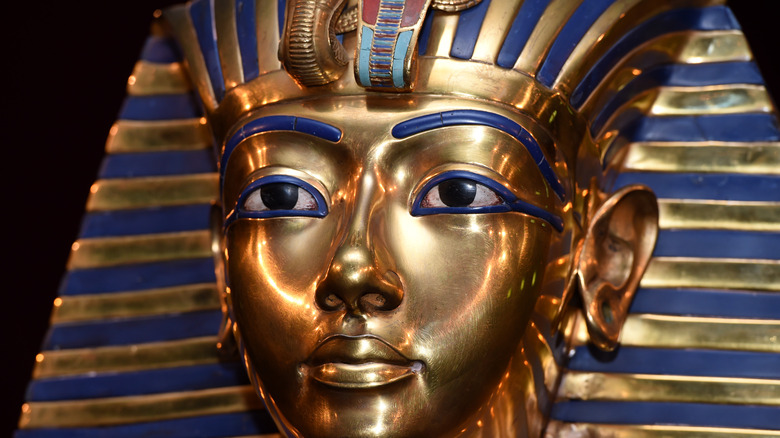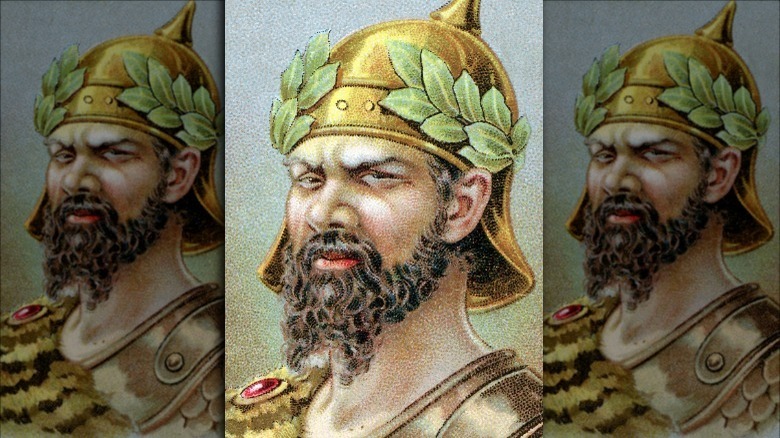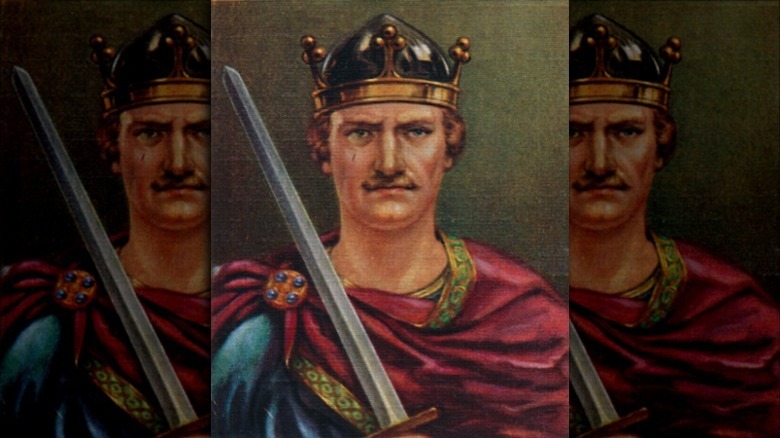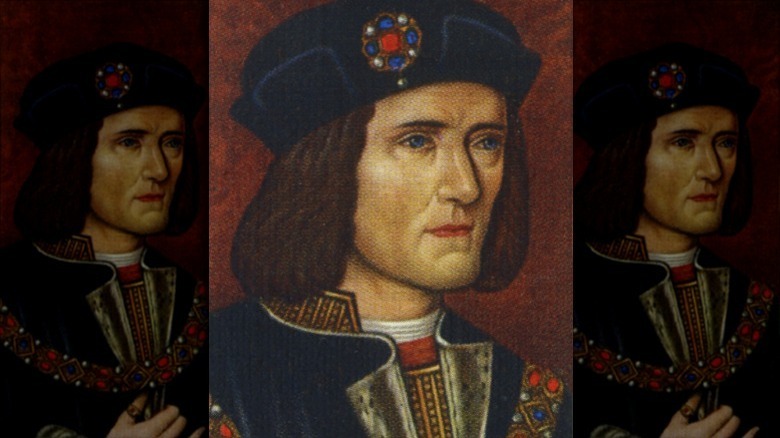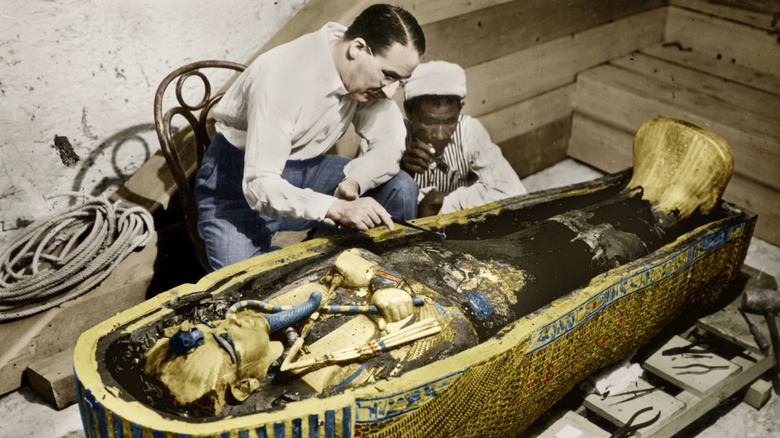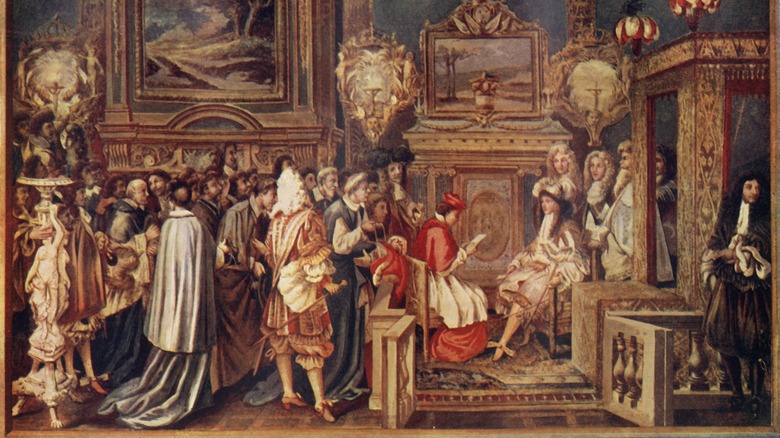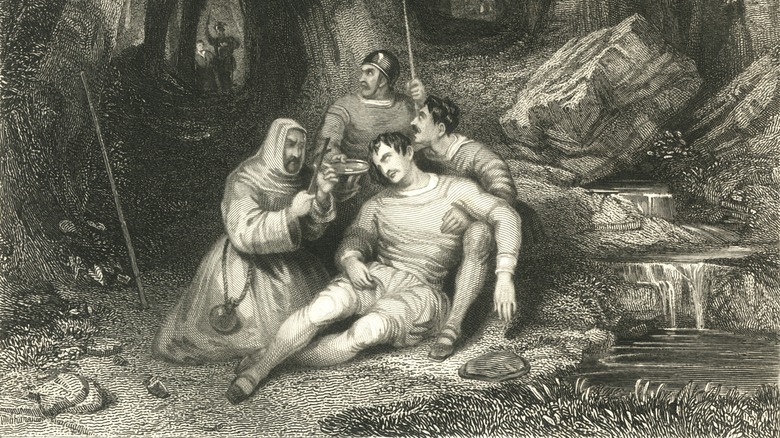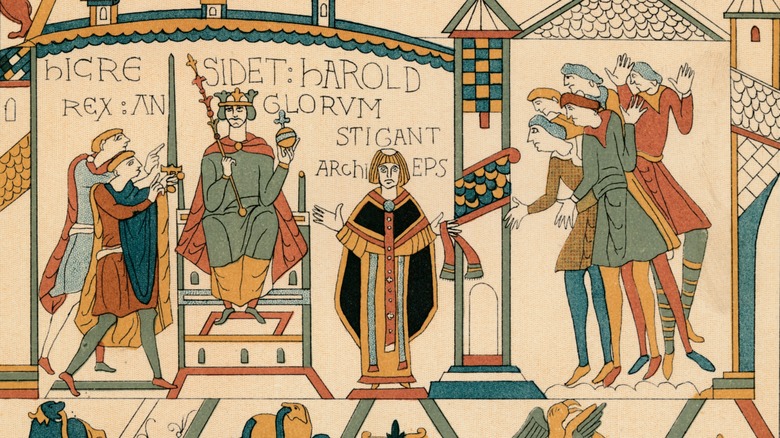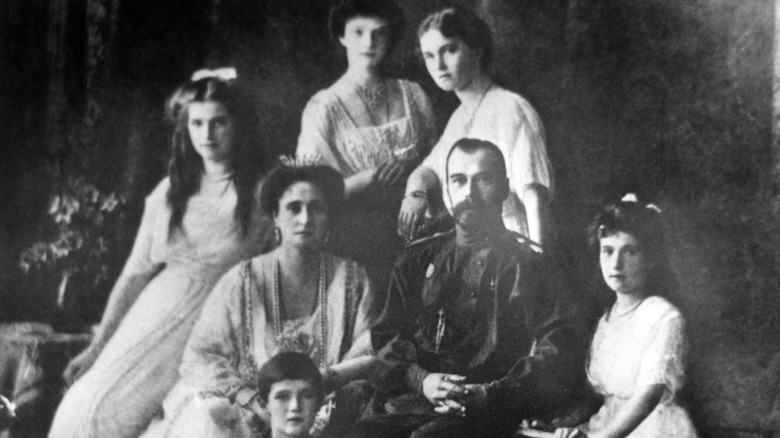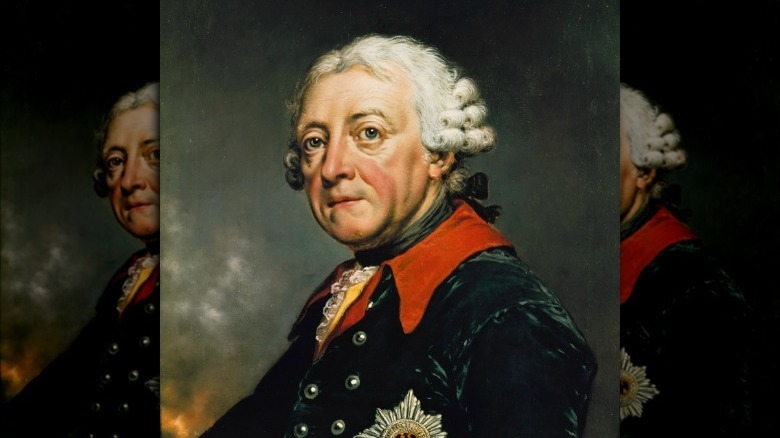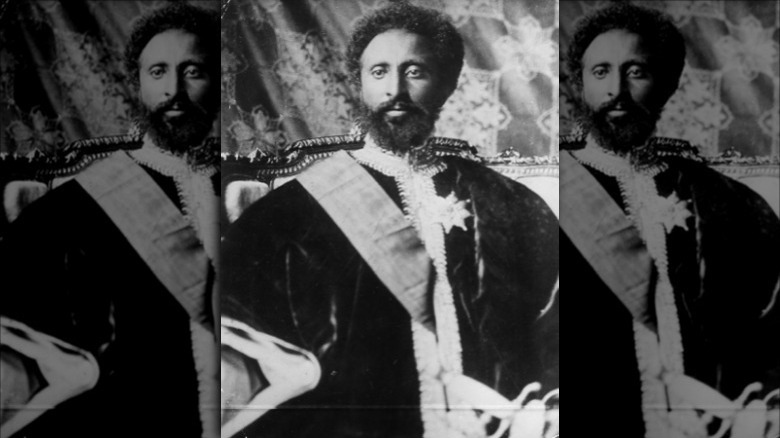Here's What Happened To The Bodies Of The Most Famous Kings In History
Being a king seems like it would be a pretty great gig. Even back in the old days when being a king came with a lot of violent baggage (leading your army into battle, constant attempts to murder you and steal your crown, etc.) it's easy to see the attraction. Look at any picture of a king and you'll probably see a well-fed guy in fancy clothes smirking at you across time, pretty pleased with himself.
You might imagine that kings, being so important and powerful, always got some pretty elaborate funerals, and their mortal remains were always treated with respect and dignity. In that, you'd be wrong. The thing about being king is that the moment you die, you pretty much stop being a king, and there's usually a brand-new monarch almost immediately. A direct side-effect of that transfer of power is that people sometimes lack the motivation to worry about your funeral — or, in many cases, your body.
In fact, history is full of gruesome stories concerning recently dead kings and the treatment they received. For every somber state funeral honoring the legacy of a recently deceased monarch, there's a story involving callous disregard, hurried burials in unmarked graves, and even violence. Here's what happened to the bodies of the most famous kings in history.
Attila, king of the Huns: Sealed inside a triple coffin
History reports that Attila, king of the Huns, liked to call himself "Flagellum Dei" (Scourge of God), which gives you some idea of what a lovely person he was. As noted by Smithsonian Magazine, the name Attila the Hun remains shorthand for someone who is brutally violent. Even considering the violent and chaotic period of history he lived in (the fifth century, when the Western Roman Empire was collapsing), Attila stood out.
After harassing the Roman Empire for years and establishing his reputation for savagery, Attila died in 453, after marrying a woman named Ildico. History Extra reports that Attila celebrated his new marriage with one heck of a party, and stayed up late drinking and feasting. He apparently suffered some kind of seizure and retired to his bedchamber. When his servants came back in the morning, they found him dead, Ildico weeping at his side. It's thought that blood vessels had burst in his throat, and he literally drowned in his own blood.
Then things get weird. According to Discover magazine, Attila was buried inside three nesting coffins — one of iron, one of silver, and one of gold. Rumor has it that the gravediggers were then executed so that the burial site would remain secret. According to the Vintage News, it has to this day, though some historians speculate that his grave was probably located and plundered shortly after his burial.
William I: Robbed blind, ignored, and then exploded
William I, also known as William the Conqueror, was the illegitimate Norman aristocrat who took possession of England in 1066 when he defeated the Anglo Saxon king Harold Godwinson at the Battle of Hastings. That instantly made William one of the most famous kings of all time.
William ruled England for the next 21 years and continued to fight for territorial rights in the north, as well as back home in Normandy. History explains that William grew quite fat in his later years, and according to Historic UK, in 1087 William was mortally wounded when he was thrown onto the pommel of his saddle. Britannica tells us that he was carried to the priory of St. Gervais near Rouen in France, where he lay dying for several weeks.
On his deathbed, William divided his lands, conferring the kingdom of England to his son William Rufus, who immediately departed to secure his new lands. The moment William was dead, in fact, everyone basically high-tailed it out of Rouen. The king's body was left unattended, and just about everything of value, including his clothes, was stolen. Then he was allowed to rot for a while, until finally some arrangements were made to bury him.
Then, at his funeral, everyone discovered that his corpse wouldn't fit into the coffin, and when they attempted to force the issue, William's gas-bloated body exploded. To say it probably didn't smell good was an understatement.
Richard III: Buried under a parking garage
It takes a lot of skulduggery to earn a play from Shakespeare when you held the crown for just two years, but Richard III was nothing if not ambitious. History Extra explains that Richard was named protector of the young king Edward V in 1483. Instead of, you know, protecting Edward, he had him imprisoned in the Tower of London, along with his younger brother. Neither was ever seen again, and they were almost certainly murdered there. Through the time-honored technique of murdering his enemies and ginning up dubious legal justifications, Richard soon arranged to have himself declared King Richard III.
Richard wasn't popular, and his claim to the crown was understandably opposed, leading to the final stages of the Wars of the Roses in which Henry Tudor successfully defeated Richard at the Battle of Bosworth. According to the Washington Post, Richard III's death was brutal and violent — he was basically hacked to death by several people. CNN reports that Richard's body was then slung over a horse and carried to Leicester, where it was put on display as proof that he was dead. He was then placed in a simple grave at the Church of the Grey Friars, which was subsequently rebuilt, and his body lost.
Until 2013. National Geographic reports that a skeleton found under a parking lot at the site of the former church was positively identified as the ignominious grave site of Richard III.
King Tutankhamen: Buried with priceless treasure, now on display
King Tutankhamen is probably the most famous Egyptian Pharaoh of all time. "King Tut" was briefly the 1970s-equivalent of a viral meme thanks to the pristine state of his elaborate burial chamber and the comic stylings of comedian Steve Martin. Which is ironic, because as History Collection explains, Tutankhamen was a minor monarch in the history of Egypt. In fact, the treasure filling his tomb were probably looted from existing tombs.
When King Tutankhamen's tomb was discovered in 1922, however, its lavish nature and pristine condition made him instantly famous and historically important. History explains that the tomb remained sealed for more than 3,000 years and offered historians and archaeologists an incredible glimpse of life in ancient Egypt.
King Tut's body was mummified according to Egyptian religious requirements, and a golden portrait mask was placed over his head. His body was installed inside a series of nested sarcophagi. The mask, however, was almost certainly repurposed from another burial site, and so the face depicted on it probably isn't Tutankhamen's at all. After the discovery of the tomb, King Tut became famous, and his body remains on display in the Valley of the Kings in Egypt inside a glass case. After enjoying ultimate privacy for 3,000 years, King Tut is now the most visible corpse in the world.
James IV of Scotland: Left in a woodshed, head stolen, lost
Kings are often put in the difficult position of choosing between family and country. James IV of Scotland was brother-in-law to Henry VIII of England, but that didn't stop him from causing England all kinds of trouble. Britannica explains that this hit a boiling point in 1512, when James ignored the "treaty of perpetual peace" he'd signed with Henry's father in 1502, threw in with the French, and declared war on England. The BBC explains that this led to James IV also being excommunicated from the Catholic church.
James initially did well against England, but in August of 1513 he was defeated pretty soundly at the Battle of Flodden, and was killed. Because of his excommunication, he couldn't be buried in the usual way. His body was sent to London, and eventually wound up stuffed into a woodshed at Sheen monastery. After some years, poor James' head fell off his body. There are plenty of rumors about what happened to the head, but no one knows for sure.
No one knows where the rest of his body is either — the monastery was demolished, and a golf course sits where it used to be, so it's possible that James is under one of the tees.
Louis XIV: The Sun King's body was divided into three parts
Louis XIV earned his nickname, the Sun King. He ruled for an astounding 72 years, and during his lifetime he dominated France and Europe in a way few others have. He turned a small hunting lodge at Versailles into the seat of his government, shifting power away from Paris and the French nobility focusing it on himself personally, once famously stating "L'etat est moi" (I am the state).
But even Louis couldn't live forever, and in 1715 he succumbed to gangrene. And then things got really weird.
Art Daily explains that royal tradition required that Louis be cut open, with his heart, entrails, and corpse embalmed separately and then placed in lead caskets. The coffin was then put on display so the court could pay its respects, then the three parts of Louis were installed at different locations so people would have options when it came to paying homage to the king.
Hyperallergic reports that Louis's body wound up at Saint-Denis without any sort of marker, which is surprising considering the pomp and luxury the king enjoyed in life. His entrails wound up at Notre-Dame de Paris, where they remain in an unmarked barrel. And his heart is buried at the Église Saint-Paul-Saint-Louis on Rue Saint-Antoine in Paris.
Llywelyn ap Gruffudd: His head on a pike for years
Although Llywelyn ap Gruffudd ruled Wales like a king, he was technically only ranked a prince — the English continue to name their heir apparent Prince of Wales as an ancient reminder that they conquered Wales, in fact.
Britannica explains that Llywelyn ap Gruffudd was the only native Welsh ruler to be officially recognized as Prince of Wales by the English, in 1267. In exchange for this recognition, Llywelyn recognized King Henry III as his feudal overlord. But when Henry died, Llywelyn defied the new king, Edward I, and a series of wars broke out. According to History Hit, at the Battle of Orwin Bridge Llywelyn arrived after the fighting had begun, and was killed almost accidentally by an English soldier who didn't recognize him.
When the soldiers realized that they'd just killed the Prince of Wales, the New York Times reports that they decapitated Llywelyn and sent his head to London, where it was placed on a pike on the gatehouse of the Tower of London. It stayed there for a long time — possibly as long as 15 years — as a grim reminder of what happens when you defy the King of England.
Harold Godwinson: Brutally hacked to pieces
In the Middle Ages, kings were routinely expected to lead their armies into battle. In 1066, King Harold Godwinson, the last Anglo-Saxon king of England, got a workout. Britannica explains that in September of 1066, Harold led his army north to fight off Norwegian invaders. He'd no sooner claimed victory there when he received word that William of Normandy had landed at Hastings. Harold had to gather up his exhausted army and marched south, where it's safe to say the Battle of Hastings did not go his way, as it ended with William claiming the title of King William I.
As bad as the battle went for Harold's army, it went worse for Harold on a personal level. There are conflicting accounts of his death, including the famous Bayeux Tapestry. It's widely accepted that he was shot in the eye by an arrow, but it's noteworthy that this method of death was the "proper fate of perjurers" in the Middle Ages. Some sources report that Norman knights hacked Harold II to death with their swords. According to History Extra, Harold's body was so mauled by violence that his lover, Edith Swannesha, had to be brought in to identify it based on "certain marks" on his private areas. No one knows what happened to the king's body after that.
Nicholas II: Burned, doused in acid, left in a ditch
How it started: the BBC explains that when Nicholas ascended to the throne in 1894, Russia was both the largest and least developed modern country. How it ended: the Bolshevik Revolution in 1917, the success of which was due in no small part to Nicholas's own incompetence.
Smithsonian Magazine explains that Nicholas actually believed that after he abdicated the throne and was arrested by the Bolsheviks, he and his family would be allowed to retire to their lavish estates in Crimea. So after being held prisoner for several months and moved from place to place, History reports that no one was more surprised about being executed than Nicholas himself. He and his family were shot execution style, but this didn't kill all of them, and their executioners eventually had to step forward and beat some of the Tsar's family to death with the butts of their weapons.
And then things got worse. The Bolsheviks didn't want news of the assassinations getting out, so the bodies were driven out to a local mine. They were robbed of valuables, covered in acid, and buried. The grave turned out to be too shallow, however, and the murderers worried they would be found. So, putting on their thinking caps, they tried to collapse the graves ... by tossing grenades at them.
When this didn't work, they dug the bodies out, moved them to a second location, buried them again, and then set them on fire.
Charles I: Forgotten in a shared tomb
Britannica reports that Charles I believed that as king he'd been chosen by God to rule England, and thus he answered to no earthly authority. Over the course of his 24-year reign, Charles managed to anger just about every aspect of his own kingdom, leading to a Civil War and his eventual execution. England was temporarily transformed into a commonwealth instead of a kingdom as a result. Considering he'd been tried, convicted, and beheaded for tyranny, it's kind of surprising that the government made any sort of funeral arrangements for Charles I at all. But the population of England were upset and uneasy about the execution of a reigning king, so the powers that be thought it smart to give Charles an official burial at Windsor Castle.
Instead of putting any thought or money into it, however, they simply took Charles's head and body, put them in a coffin, and stuck the coffin in the same small room as Henry VIII and Jane Seymour. Henry had been put there until the elaborate tomb he'd planned was built — except none of his children bothered to build that tomb, so he just stayed at Windsor. The BBC reports that after Charles I was shoved in there with Henry, the room was largely forgotten. It was rediscovered by chance in 1813, and in 1837 King William IV finally had a marker placed above it.
Frederick the Great: Exhumed by Hitler
Frederick II, eventually known as "the Great," was King of Prussia. Frederick expanded Prussia's power and influence, and he became a towering figure in German history. When Adolph Hitler seized power in Germany in the 1930s, he looked back to the glory days of Germany's power and influence. The Washington Post reports that Hitler linked his Third Reich and National Socialist party directly to Frederick the Great. In fact, Hitler admired Frederick so much he wound up digging up the king's body.
The Chicago Tribune explains that Frederick the Great didn't want to be buried next to his father, whom he hated, and wanted instead to be buried next to his beloved greyhound hunting dogs, which had been buried at his palace outside Potsdam. But his successor, Frederick William II, ignored his wishes and had him buried next to his father in 1786 anyway.
Frederick lay there for the next 157 years, until Allied forces started dropping bombs near Potsdam in 1943, during World War II. According to the Los Angeles Times, Hitler admired Frederick so much that he had the old king dug up and transported to a salt mine for safe keeping. After the war ended, Frederick's body was stuck on the Soviet side of the border between East and West Germany. It wasn't until 1991 that he was finally moved to his desired resting place next to his dogs.
Haile Selassie: Buried under a toilet
Haile Selassie ascended the throne of Ethiopia in 1930, becoming it's 225th emperor. He ruled for decades, and the BBC reports that he was regarded as divine by followers of the Rastafarian religion. That didn't stop economic and political problems from sparking a coup that saw him removed from office in 1974.
Biography explains that a year after the coup, when Selassie was 83 years old, he passed away. Initial reports that he'd died of natural causes were immediately rejected, and there is evidence the elderly king was actually strangled or smothered to death. For years, the location of his earthly remains were a mystery. Then, as reported by the Associated Press, in 1992 another revolution ousted the government of President Mengistu Haile Mariam. The new government ordered that Selassie's body be located and exhumed. His body was eventually discovered — buried under a toilet at his former palace. The new government claimed that Mengistu had placed the body under his own office in order to prevent the old emperor from rising from the dead.
The body was transported to Ba'ata Mariam Geda Church in Addis Ababa. The BBC reports that Selassie was finally buried properly in Trinity Cathedral in 2000. The government didn't allow a state funeral, however.
